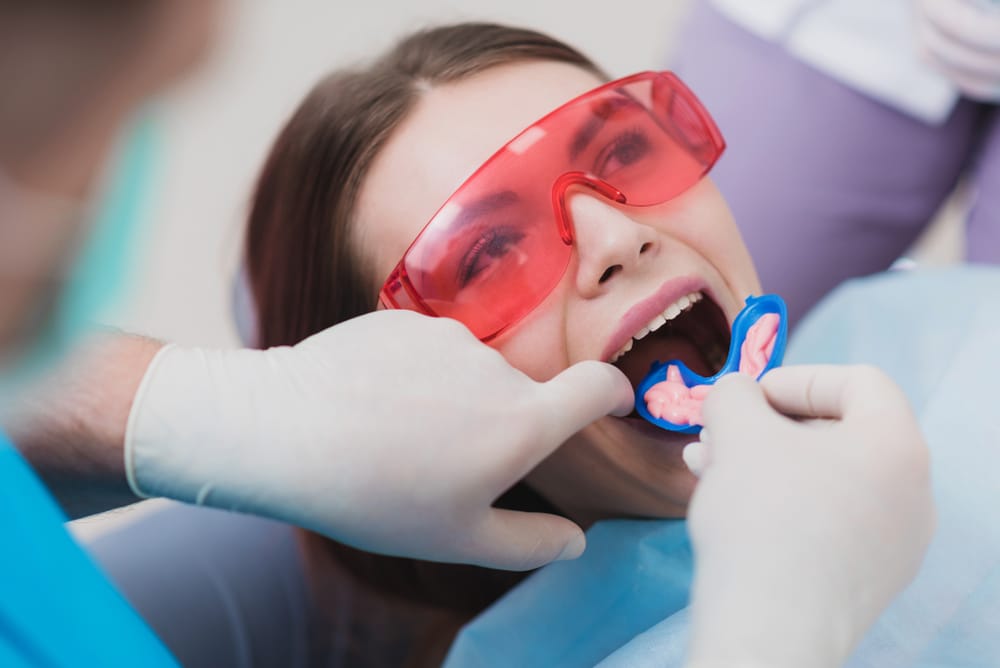
Perhaps you remember having to endure fluoride treatments when you were a kid. For many, it was bi-annual visits to their dentist for a dental cleaning followed by a foam-in-tray fluoride treatment. For others, you may recall the pink fluoride rinse that you swished twice a year at school.
There is no doubt that fluoride treatments have changed throughout the years. Today’s standards are that children receive fluoride varnish treatments as part of their preventive dental routine.
Fluoride varnish is a painless and straightforward process. The varnish is painted on the teeth following a dental cleaning, and post-care instructions are given not to chew any crunchy foods for the next several hours. As the varnish mixes with saliva, it hardens onto the teeth for added strength and protection. While fluoride varnishes are often offered to kids, are you wondering about fluoride varnishes for adults?
Fluoride Benefits
Whether being applied to young or old, fluoride offers these great benefits!
- Prevents tooth decay – Fluoride makes teeth more resistant to acid attacks from sugars and plaque in the mouth.
- Reversal of early decay – Small incipient areas of decay can start on the outer layer of your teeth. If you get adequate fluoride uptake, these starting areas of decay can be reversed before they reach deeper into your tooth, at which they will need a filling.
- Less severe cavities – Rampant, severe decay is less likely in those who have fluoride routinely as part of their dental prevention.
- Reduces the need for fillings and tooth removal – Building up stronger teeth over time means that there will be less need for fillings and extractions in the long run.
In-Office Fluoride
Your dental hygienist can apply a fluoride varnish treatment for you after your next dental cleaning. Fluoride varnish works best following a thorough cleaning so that the fluoride can best protect your teeth. It is a simple process that only takes a few minutes, and it is also a very cost-effective way to protect your teeth!
Elderly And Root Decay
Those over 50 years of age are at greater risk for root decay. As you age, your risk of gum recession increases. Gum recession exposes the root surface of your teeth, leading to sensitivity and root caries.
In-office fluoride treatments can benefit your teeth by making them stronger and reducing your risk of cavities, even cavities that can develop on your teeth root surfaces. Should you be dealing with sensitivity, fluoride treatments can also help in areas of root sensitivity.
Prevention Is Always Best
When it comes to your teeth, natural teeth are always best. There is no more affordable option out there than using the teeth that you were given. While fluoride is highly recommended as an easy and inexpensive way to build up your teeth to stay strong and healthy, other prevention techniques should also be mentioned as very important.
- Brushing twice a day – Did you know that plaque reforms on your teeth minutes after brushing them? It is vital to be disrupting this plaque layer on a routine basis.
- Flossing once a day – Cavities and gum disease can start in the areas between your teeth where your toothbrush can’t reach. Make sure to floss daily to break up the biofilm and debris hidden in these hard-to-reach areas.
- Swishing with mouth rinse – Swishing daily can help to kill some of the harmful bacteria in your mouth. If you swish with a fluoride mouth rinse, it is an additional way for your teeth to get the fluoride that they need.
- Limit acidic and sugary drinks – Reducing your exposure to sugar and acid is very beneficial in reducing your risk of cavities. Try to replace some of these sugary options with water.
If you are an adult struggling with tooth sensitivity or dental caries, we highly recommend a fluoride varnish treatment at your next dental cleaning. Our dentists want our patients to know that building strong teeth doesn’t have to be complicated, painful, or expensive. The small steps you take today are essential in boosting your oral health, and your investment will pay off in the years to come!



Leave a Reply